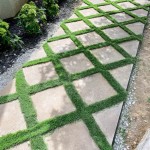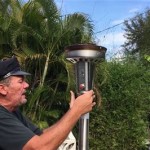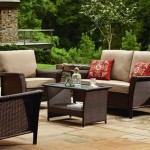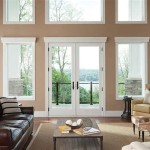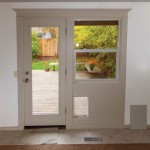How To Use a Patio Umbrella Without a Base
Patio umbrellas provide shade and comfort during outdoor activities. While patio umbrella bases are the most common method of securing an umbrella, there are situations where a base is unavailable, impractical, or aesthetically undesirable. This article explores alternative methods for stabilizing a patio umbrella without relying on a traditional base, emphasizing safety and effectiveness.
The primary challenge in using a patio umbrella without a base is maintaining stability, particularly in windy conditions. An unsecured umbrella can become a safety hazard, potentially tipping over, causing damage, or even injuring someone. Therefore, all alternative methods require careful consideration of wind resistance and overall stability.
Securing the Umbrella to a Table
One of the simplest ways to use a patio umbrella without a base is to utilize a patio table with an umbrella hole. This method leverages the table's mass and structure to provide stability. However, not all tables are suitable. The table's weight and diameter are crucial factors in determining its effectiveness.
Tables made of heavier materials, such as wrought iron, cast aluminum, or solid wood, offer more inherent stability than lightweight plastic or resin tables. A larger diameter also contributes to stability, as it provides a wider footprint to resist tipping. It is imperative to assess the table’s capacity before relying solely on it to support the umbrella.
When using a table, it is crucial to ensure the umbrella pole fits snugly within the table's umbrella hole. If the pole is too small, it may wobble and become unstable. Shims, such as rubber or plastic inserts, can be used to tighten the fit and reduce movement. These shims fill the gap between the pole and the table hole, preventing the umbrella from leaning or rotating excessively.
For added security, consider using clamps or straps to further secure the umbrella pole to the table legs. This provides an additional layer of stability, particularly in areas prone to strong winds. Choose clamps that are weather-resistant and designed for outdoor use to prevent rust and corrosion. Regularly inspect the clamps and straps for wear and tear, replacing them as needed.
Even with a heavy table, this method may not be sufficient in high wind conditions. Therefore, it is advisable to retract the umbrella when strong winds are anticipated or observed. A closed umbrella presents a smaller surface area to the wind, significantly reducing the risk of tipping.
Utilizing Ground Anchors and Stakes
Ground anchors and stakes offer a more direct method of securing a patio umbrella to the ground. This approach is particularly suitable for umbrellas used on lawns, in gardens, or on other soft surfaces. The effectiveness depends on the type of soil and the depth to which the anchors or stakes are driven.
Various types of ground anchors are available, including screw-in anchors, corkscrew anchors, and spike anchors. Screw-in anchors are generally considered the most secure, as they provide a firm grip in the soil. Corkscrew anchors are suitable for less dense soil, while spike anchors are best for temporary or light-duty applications.
To install a ground anchor, first determine the desired location for the umbrella. Then, use a tool, such as a wrench or screwdriver, to twist the anchor into the ground until it is securely embedded. The depth to which the anchor is driven will vary depending on the soil type and the size of the anchor. A general guideline is to bury the anchor at least half its length.
Once the anchor is in place, attach the umbrella to the anchor using ropes, straps, or bungee cords. Ensure the connections are tight and secure, and that the umbrella is positioned upright. It may be necessary to use multiple anchors to provide adequate stability, especially for larger umbrellas or in windy areas. Position the anchors around the perimeter of the umbrella, spacing them evenly to distribute the load.
When using ground anchors, regularly inspect them to ensure they remain firmly embedded in the ground. Soil can become loose or eroded over time, which can compromise the anchor's grip. If an anchor becomes loose, re-tighten it or move it to a new location. Also, consider the type of soil. Sandy soil offers less resistance than clay soil, requiring longer or more robust anchors.
It is important to consider the potential for tripping hazards when using ground anchors. Ensure the ropes or straps connecting the umbrella to the anchors are clearly visible and do not create an obstruction. Consider using brightly colored ropes or flags to increase visibility. This is particularly important in areas with high foot traffic.
Creating a DIY Weighted Container
Constructing a do-it-yourself (DIY) weighted container provides a customizable and cost-effective alternative to a traditional patio umbrella base. This method allows for flexibility in terms of materials, size, and aesthetic design. The key is to create a container that is heavy enough to counteract the umbrella's tendency to tip over.
Suitable containers for a DIY weighted base include large planters, plastic barrels, or even repurposed items such as tires or metal drums. The container should be durable, weather-resistant, and large enough to accommodate the umbrella pole. The size and weight of the container will depend on the size of the umbrella and the typical wind conditions in the area.
To add weight to the container, consider using materials such as sand, gravel, concrete, or bricks. These materials are readily available and relatively inexpensive. Fill the container with the chosen material, ensuring it is packed tightly to maximize its density. Leave enough space at the top of the container to accommodate the umbrella pole.
To secure the umbrella pole in the container, create a central hole that is slightly larger than the pole's diameter. A PVC pipe sleeve can be inserted into the hole to provide a snug fit and prevent the pole from rattling. The sleeve can be secured to the container using adhesive or screws. Alternatively, quick-setting concrete can be poured around the pole to create a solid, permanent base.
For added aesthetic appeal, the container can be decorated or covered to match the surrounding decor. Paint, stain, or decorative stones can be used to enhance the container's appearance. Fabric or netting can be wrapped around the container to conceal the weighted materials. Consider adding plants or other decorative elements to the container to blend it seamlessly into the outdoor environment.
When constructing a DIY weighted container, prioritize safety and stability. Ensure the container is placed on a level surface and is not prone to tipping or rolling. Regularly inspect the container for cracks or damage, repairing them as needed. For very large umbrellas or in areas with high winds, consider using multiple weighted containers to provide additional support.
Regardless of the method chosen, the ultimate goal is to ensure the safety and stability of the patio umbrella. Regularly inspect the chosen method and make adjustments as necessary. Prioritize safety over aesthetics when selecting an alternative to a traditional base. Consideration of local weather conditions and potential hazards is paramount.

Make Your Own Umbrella Stand Side Table

Diy Patio Umbrella Stand 4 Suggestions Large Umbrellas Shade Backyard Oasis

Diy Patio Umbrella Stand I Give No Sips

From The Base Up A Buyer S Guide To Patio Umbrella Bases Best Choice

The Ultimate Patio Umbrella Buyers Guide

Casainc 11 Ft Square Cantilever Hydraulic Lifting Large Offset Outdoor Patio Umbrella In Blue Without Base Ca Wg02ny The Home Depot

Casainc 11 Ft Square Cantilever Hydraulic Lifting Large Offset Outdoor Patio Umbrella With Led Light In Blue Without Base Ca Ledwg02ny The Home Depot

Mainstays 10 Navy Blue Octagon Outdoor Tilting Cantilever Offset Patio Umbrella With Weighted Base And 360 Degree Rotation Com

Plastic Umbrella Stand Best Choice S

Casainc 11 Ft Square Cantilever Hydraulic Lifting Large Offset Outdoor Patio Umbrella With Led Light In Blue Without Base Ca Ledwg02ny The Home Depot
Related Posts


